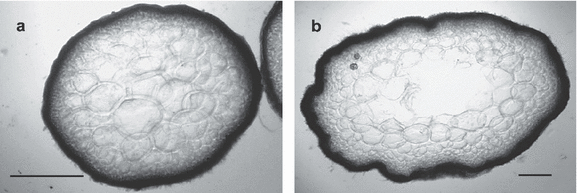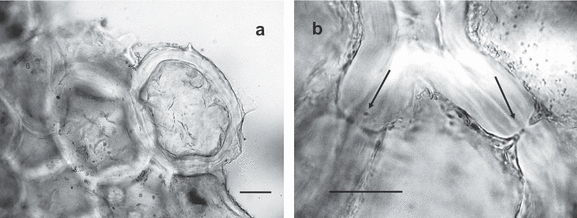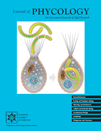FIRST RECORD OF GRACILARIA VERMICULOPHYLLA (GRACILARIALES, RHODOPHYTA) IN THE PO DELTA LAGOONS, MEDITERRANEAN SEA (ITALY)1
Received 19 June 2009. Accepted 30 June 2010.
Abstract
Molecular outcomes led us to report the first occurrence of the invasive alien species Gracilaria vermiculophylla (Ohmi) Papenf. in the Mediterranean Sea. This species was recorded for the first time in the Po Delta lagoons in May and October 2008, probably introduced by the importation of the Manila clam Tapes philippinarum. At present, G. vermiculophylla is spread only near some clam-farming areas, but its diffusion is expected to increase with the colonization of other lagoons where aquaculture is spread, as already observed for other alien species such as Agardhiella subulata and Solieria filiformis. The present study supplies further information on the morphology of this species, the ecological characteristics of the colonized areas, and the most probable introduction vector, confirming that the species spreading occurs in eutrophic and turbid coastal systems.
Abbreviations:
-
- cox
-
- cytochrome oxidase
-
- psu
-
- practical salinity units
-
- rbcL
-
- LSU of the RUBISCO gene
Over the past two decades, the Mediterranean Sea has been colonized by several allochthonous macroalgae mainly coming from the Indo-Pacific area. Such taxa spread in wider regions finding numerous habitats adapted for their growth (Boudouresque and Verlaque 2002, Cormaci et al. 2004). Moreover, such invasion was supported by the increase of tourist and commercial naval traffic with extra-Mediterranean countries, the import of fish products, and aquaculture activities (Sfriso and Curiel 2007).
Due to such activities, every year, especially in the Venice Lagoon, the most studied Mediterranean environment, new introduced species are recorded (Occhipinti-Ambrogi 2000), mainly macroalgae (Cecere et al. 2009). Since 1983, when the most recent studies on the lagoon vegetation started (Sfriso and Curiel 2007), 92 new species have been found, 20 of which are allochthonous. Some of these, such as Sargassum muticum, Undaria pinnatifida, and A. subulata, are invasive species that have replaced almost completely the autochthonous species.
A sampling carried out in the Po Delta lagoons in May and October 2008 allowed discovery of a new invasive species: G. vermiculophylla, a macroalga known previously from the Northwest Pacific (Ohmi 1956, Yoshida et al. 1995, Tseng and Xia 1999); Virginia (USA) (Thomsen et al. 2005); British Columbia (Saunders 2009); North Carolina (Freshwater et al. 2006); the European Atlantic coasts of France, Spain, Portugal, the Netherlands, and Sweden (Barbara et al. 2005, Rueness 2005); the tidal flats of the Wadden Sea (Thomsen et al. 2007); the Baltic Sea (Weinberger et al. 2008); and the African Atlantic coasts of Morocco (Guillemin et al. 2008).
The species that was recorded in May 2008 in three lagoons of the Po Delta showed an increasing spreading in October because it colonized two other lagoons in the southern part of the delta (Sfriso and Facca 2008). As the water circulation of the North Adriatic Sea exhibits a north–south direction, G. vermiculophylla is also expected to colonize other very eutrophic lagoons in the south, such as Scardovari and Pialassa della Baiona. Sampling campaigns have been planned to verify this hypothesis.
This study aims at describing new morphological features of this species and comparing the rbcL and cox2-3 gene sequences of our isolate strains with those available in the literature. We also describe the site environmental characteristics where G. vermiculophylla was found predicting its potential spreading in other sites where clam farming is present.
Sampling. G. vermiculophylla was collected in May 2008 in some lagoons of the Po Delta: Marinetta (geographic coordinates: 45°03′40″ N, 12°21′13″ E), Vallona (45°02′42″ N, 12°22′57″ E), and Barbamarco (44°59′04″ N, 12°28′43″ E). In October, some samples were also recorded in the lagoons of Canarin (44°56′12″ E, 12°28′43″ E) and Scardovari (44°50′18″ N, 12°24′46″ E).
Samples were fixed in 4% formaldehyde/seawater solution for the morphological observations or freeze-dried for the molecular analyses.
Molecular procedures. The extraction of DNA was carried out using the Genomic DNA purification kit (Fermentas International Inc., Burlington, Ontario, Canada). The rbcL gene was amplified according to Freshwater and Rueness (1994), while the cox2-3 mitochondrial DNA spacer was amplified following procedures and primers as described by Zuccarello et al. (1999). The PCR amplifications were cleaned with ExoSAP-ITTM kit (GE Healthcare, Uppsala, Sweden) or, in case of multiple bands, purified with the DNA Gel extraction kit (Millipore Corporation, Billerica, MA, USA) following the manufacturer’s protocol. DNA sequencing was performed at the BMR Genomics Sequencing Service (University of Padua, Italy) on automated ABI DNA sequencers (Applied Biosystem, Foster City, CA, USA). Final consensus sequences were assembled using the SeqMan II program from the Lasergene software package (DNAStar©, Madison, WI, USA). Identity of new sequences was checked by using the BLAST program (Altschul et al. 1990) available at the National Center for Biotechnology Information (NCBI, Bethesda, MD, USA) Web server (http://www.ncbi.nlm.nih.gov). The rbcL and the cox2-3 mitochondrial DNA spacer gene sequences of the G. vermiculophylla collected in the Po Delta lagoons were deposited in DDBJ/GenBankTM/EBI Data Bank with the accession numbers FN400862 and FN400863, respectively. The voucher specimen used for molecular analysis is available at the laboratory of A. Sfriso (University of Venice, Italy).
To establish the taxonomic status of the strain isolated from the Po Delta lagoons, we performed a molecular analysis. At first, the rbcL gene was sequenced and compared with data available in public data banks (Table 1). The partial plastidial gene sequence was 1,302 bp long and spanned from base pair position 58 to 1,359 of rbcL gene sequence covering the 88.7% of the complete gene sequence. The comparison of rbcL gene sequence of our strain with other ones, available in GenBank, revealed the highest percentage of identity (100%) with a strain of G. vermiculophylla, collected from North Carolina (EU600293) (Hommersand and Freshwater 2009), and several other vouchers of this species, sampled mainly from localities of Japan (EU600293) and South Korea (DQ095820) (Yang et al. 2008). Subsequently, the cox2-cox3 spacer was completely sequenced to better define the taxonomic position of our strain and comprised 136 nucleotides. The cox2-cox3 spacer sequence showed a percentage of similarity of 100% with the sequences of 22 specimens recovered from distinct localities reported by Rueness (2005), which strongly confirm conspecificity.
| Voucher | Collection data | Accession no. | % of identity | Coverage (bp) |
|---|---|---|---|---|
| rbcL | ||||
| np | Japan: Hokkaido | EU600293 | 100 | 1,302 |
| G223 | South Korea: Taean: Bangpo | DQ095821 | 100 | 1,302 |
| G219 | South Korea: Gosung: Sangjokam 2 | DQ095820 | 100 | 1,302 |
| G221 | South Korea: Gosung: Sangjokam 1 | DQ095819 | 100 | 1,302 |
| G367 | South Korea: Jeju: Oidodong | DQ095818 | 100 | 1,302 |
| G38 | South Korea: Jeju: Sungsan | DQ095817 | 100 | 1,302 |
| G366 | South Korea: Jeju: Haengwon | DQ095816 | 100 | 1,302 |
| G47 | South Korea: Jeju: Hado | DQ095815 | 100 | 1,302 |
| np | France: St. Pol-de-Leon, Brittany | AY725172 | 99 | 1,302 |
- np: not present.
This mitochondrial marker has been shown to be variable within species and even within populations. In particular, the cox2-cox3 spacer region has the potential to be useful in population and demographic studies of red algae (Zuccarello et al. 1999). This finding, besides confirming the rbcL result, represents a new record of this species.
The samples from the Po Delta lagoons show morphological features of G. vermiculophylla species, according to the extensive description by Terada and Yamamoto (2002) and Rueness (2005). However, our isolate exhibits some peculiarities. All the filaments in cross-sections show extensive hollows (Fig. 1), except in the ends. Moreover, medullary cells are surrounded by a thick, colorless cell wall measuring 10–20 μm (Fig. 2a). Between the walls of neighboring cells, many pit-connections of 20–25 μm in length are distinguishable (Fig. 2b). In addition, cystocarp nutritive-fusiform cells between the gonimocarp and pericarp, which are one of distinctive character of the genus Gracilaria, were not observed in our samples. This character in G. vermiculophylla is very rare, as already reported by Thomsen et al. (2005).

Cross-section of the apical (a) and median (b) regions of a filament. Scale bars, 300 μm.

Details of the medullar cells: the thick colorless walls (a) and the bridges (b) between cells (arrows). Scale bars, 30 μm.
G. vermiculophylla was first reported in the European coasts in 1996 (Rueness 2005) and, subsequently, rapidly spread along the whole Atlantic, North Sea, and Baltic Sea coasts without being limited by low-salinity waters. The most probable introduction vectors were oyster farms (Rueness 2005) that imported these bivalves from the Virginian oyster reefs where G. vermiculophylla is abundant (Thomsen et al. 2005). Local spreading is most likely due to other vectors, such as small boats, anchors, nets, and other fishing tools. This species usually forms loose-lying plants on mud or fine sand in shallow protected bottoms of bays and estuaries; more rarely, it is attached to mollusk shells or stones. It is commonly found in seagrass beds of Zostera marina or Nanozostera noltii, but it can also form tangled mats together with other species, such as Ulvaceae. It tolerates low salinities (<10 psu), and its dispersal is increased by the frequent thalli fragmentation, primarily the result of grazing (Thomsen et al. 2007).
In the Adriatic Sea, G. vermiculophylla was recorded in some lagoons of the Po Delta in May and October 2008 (Sfriso and Facca 2008). Because these lagoons have no touristic ships and commercial traffic, the most probable introduction vector is likely clam farming and the importation of the Manila clam T. philippinarum as observed for other allochthnous invasive species (Sfriso and Curiel 2007).
These lagoons are shallow, strongly eutrophicated, and turbid environments where salinity can change according to the Po River outflows. During sampling, the Po water outflow in the delta lagoons was regular; however, the values of some environmental parameters (Facca et al. 2009) are summarized in Table 2.
| Mean ± SD | Min. | Max. | ||
|---|---|---|---|---|
| Water temperature (°C) | May | 22.9 ± 1.3 | 21.0 | 25.2 |
| October | 19.3 ± 0.47 | 18.1 | 19.9 | |
| Water transparency (m) | May | 1.05 ± 0.31 | 0.5 | 1.5 |
| October | 1.1 ± 0.45 | 0.45 | 2.2 | |
| Oxygen saturation (%) | May | 241 ± 52 | 157 | 334 |
| October | 87 ± 8 | 75 | 109 | |
| Salinity (psu) | May | 19.4 ± 3.8 | 14.9 | 29.2 |
| October | 27.8 ± 2.7 | 21.3 | 32.2 | |
| Reactive phosphorus (μM) | May | 0.38 ± 0.23 | 0.15 | 1.00 |
| October | 7.0 ± 9.6 | 0.10 | 24.9 | |
| Dissolved inorganic nitrogen (μM) | May | 15.9 ± 7.9 | 6.3 | 30.1 |
| October | 29.8 ± 11.9 | 15.0 | 57.8 |
The lagoons of the Po Delta are characterized by high nutrient levels and water turbidity that do not promote the growth of seagrasses. These lagoons are mainly colonized by macroalgae, especially Ulvaceae, Gracilariaceae, and Solieriaceae (Sfriso 2009). No associations with macrofaunal organisms were recorded, and this finding suggests that its introduction is very recent (1–2 years at maximum) in contrast to other invasive alien species, such as S. filiformis and A. subulata, which grow in association with many bivalves, gasteropods, and membranaceous tube-building worms. Finally, Thomsen et al. (2007) report that G. vermiculophylla is commonly found in seagrass beds of Z. marina or N. noltii; therefore, we expect that an environmental improvement cannot limit its spreading.
Acknowledgments
We would like to thank the “Agenzia Regionale per la Prevenzione e Protezione Ambientale del Veneto” (ARPAV), which supported the sampling of the Po Delta lagoons; Dr. Bruno Sebastiano and Dr. Daniele Bon for the sampling facilities; and Dr. Chiara Facca and Mrs. Sonia Ceoldo for nutrient analyses. We are also grateful to both the anonymous reviewers and the associate editor for their suggestions.




